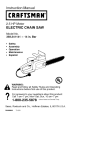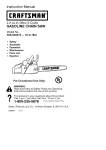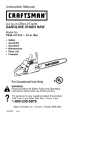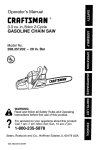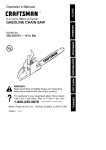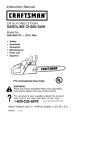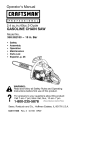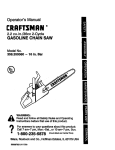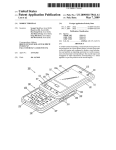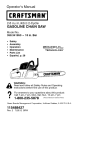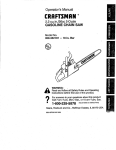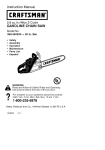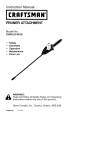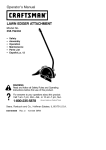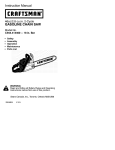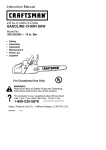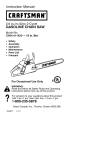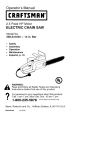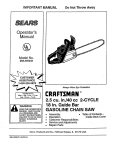Download Craftsman 358.350460 Instruction manual
Transcript
Instruction
Manual
I CRRFTSIVlRN°I
2.2 cu.in./36cc 2-Cycle
GASOLINE CHAIN SAW
Model No.
358.350460
- 16 in. Bar
Safety
Assembly
Operation
Maintenance
Parts List
For Occasional
&
WARNING:
Read and follow all Safety Rules and Operating
Instructions
before first use of this product.
For answers
Call 7 am-7
to your questions about this product:
pm, Mon-Sat;
Sun, 10 am-7 pm
1-800-235-5878
Sears, Roebuck
530088710
®
Use Only
4/17/01
and Co., Hoffman
(Hours
listed are Central Time)
Estates,
IL 60179 U.S.A.
Warranty
Safety Rules
Assembly
Operation
Maintenance
Service and Adjustments
2
2
6
7
14
17
Storage
Troubleshooting
Table
Emissions Statement
Parts List
Spanish
Parts & Ordering
19
20
22
23
26
Back Cover
FULL ONE YEAR WARRANTY ON CRAFTSMAN '_ GAS CHAIN SAW
For one year from the date of purchase, when this Craftsman Gas Chain Saw is
maintained, lubricated and tuned up according to the instruction manual, Sears
will repair, free of charge, any defect in material or workmanship.
This warranty excludes the bar, chain, spark plug and air filter, which are
expendable parts, and become worn during normal use.
If this Gas Chain Saw is used for commercial or rental purposes, this warranty
applies for 30 days from the date of purchase.
WARRANTY SERVICE IS AVAILABLE BY RETURNING THIS CHAIN SAW TO THE
NEAREST SEARS STORE OR SERVICE CENTER IN THE UNITED STATES.
This warranty gives you specific legal rights, and you may also have other rights
which vary from state to state.
Sears, Roebuck and Co,, D/817 WA, Hoffman Estates, IL 60179
_, WARNING:
Always disconnect
spark plug wire when making repairs
except for carburetor adjustments. Because a chain saw is a high-speed
woodcutting tool, special precautions
must be observed to reduce risk of accidents. Careless or improper use of
this tool can cause serious injury.
PLAN AHEAD
• Restrict the use of your saw to adult
users who understand and can follow the safety rules, precautions,
and operating instructions found in
this manual.
Hearing
_
Protection _ ,_
Snug
I w'ul_--_
Fitting -------_.
Clothing
Safety
Shoes
_
Safety Hat
Eye
Protection
Heavy Duty
Gloves
•
•
•
•
./
Safety Chaps
•
• Wear protective gear. Always use
steel-toed safety footwear with non-slip
soles; snug-fitting clothing; heavy-duty,
non-slip gloves; eye protection such
as non-fogging, vented goggles or
face screen; an approved safety hard
hat; and sound barriers (ear plugs or
mufflers) to protect your hearing. Regular users should have hearing
checked regularly as chain saw noise
can damage hearing.
Secure hair above shoulder length. Do
not wear loose clothing or jewelry; they
can get caught in moving parts.
Keep all parts of your body away
from the chain when the engine is
running.
Keep children, bystanders, and animals at least 30 feet (10 meters)
away from the work area when starting and using the saw.
Do not handle or operate a chain saw
when you are fatigued, ill, or upset, or
if you have taken alcohol, drugs, or
medication. You must be in good
physical condition and mentally alert. If
you have any condition that might be
aggravated by strenuous work, check
with doctor before operating.
Do not start cutting until you have a
clear work area, secure footing, and
especially if you are felling a tree, a
retreat path.
OPERATE
YOUR
SAW SAFELY
• Do not operate with one hand. Serious injury to the operator, helpers, or
bystanders may result from onehanded operation. A chain saw is intended for two-handed use.
• Operate the chain saw only in a wellventilated outdoor area.
• Do not operate saw from a ladder or
in a tree.
• Make sure the chain will not make
contact with any object while starting
the engine. Never try to start the saw
when the guide bar is in a cut.
• Do not put pressure on the saw, especially at the end of the cut. Doing
so can cause you to lose control
when the cut is completed.
• Stop engine before setting saw down.
• Hand carry saw only when engine is
stopped. Carry with muffler away
from body; guide bar & chain projecting behind you; guide bar preferably
covered with a scabbard.
• Do not operate a chain saw that is
damaged, improperly adjusted, or not
completely and securely assembled.
Always replace bar, chain, hand
guard, chain brake, or other parts immediately if they become damaged,
broken, or are otherwise removed.
MAINTAIN
YOUR
SAW IN GOOD
WORKING ORDER
• Have all chain saw service performed by a qualified service dealer
except the items listed in the MAINTENANCE section of this manual.
• Make certain the saw chain stops
moving when the throttle trigger is
released. For correction, refer to
CARBURETOR ADJUSTMENTS.
• Keep the handles dry, clean, and
free from oil or fuel mixture.
• Keep caps and fasteners securely
tightened.
• Nonconforming replacement components or the removal of safety devices
may cause damage to the unit and
possible injury to the operator or bystanders. Use only Craftsman accessories and replacement parts as recommended. Never modify your saw.
• Maintain chain saw with care.
• Keep unit sharp and clean for better
and safer performance.
• Follow instructions for lubricating and
changing accessories.
• Check for damaged parts. Before further use of the chain saw, a guard or
other part that is damaged should be
carefully checked to determine that it
will operate properly and perform its
intended function. Check for alignment
of moving parts, binding of moving
parts, breakage of parts, mounting and
any other conditions that may affect its
operation. A guard or other part that is
damaged should be properly repaired
or replaced by a Sears Service Center
unless otherwise indicated elsewhere
in the instruction manual.
• When not in use, chain saws should
be stored in a dry, high or locked-up
place out of the reach of children.
• When storing saw, use a scabbard or
carrying case.
HANDLE FUEL WITH CAUTION
• Do not smoke while handling fuel or
while operating the saw.
• Eliminate all sources of sparks or
flame in areas where fuel is mixed or
poured.
• Mix and pour fuel in an outdoor area
and use an approved, marked container for all fuel purposes. Wipe up
all fuel spills before starting saw.
• Move at least 10 feet (3 meters) from
fueling site before starting.
• Turn the engine off and let saw cool
in a non-combustible
area, not on
dry leaves, straw, paper, etc. Slowly
remove fuel cap and refuel unit.
• Store the unit and fuel in a cool, dry
well ventilated space where fuel vapors cannot reach sparks or open
flames from water heaters, electric
motors or switches, furnaces, etc.
GUARD AGAINST KICKBACK
Follow all safety rules to help avoid
kickback and other forces which can
result in serious injury.
Xf_'_
_
Kickback Path
Avoid Obstructions
_h, WARNING:
Avoid kickback which
can result in serious injury. Kickback
is the backward, upward or sudden forward motion of the guide bar occurring
when the saw chain near the upper tip
of the guide bar contacts any object
such as a log or branch, or when the
wood closes in and pinches the saw
chain in the cut. Contacting a foreign
object in the wood can also result in
loss of chain saw control.
• Rotational
Kickback
can occur
when the moving chain contacts an
object at the upper tip of the guide
bar. This contact can cause the
chain to dig into the object, which
stops the chain for an instant. The
result is a lightning fast, reverse
reaction which kicks the guide bar up
and back toward the operator.
• Pinch-Kickback
can occur when the
the wood closes in and pinches the
moving saw chain in the cut along
the top of the guide bar and the saw
chain is suddenly stopped. This sudden stopping of the chain results in a
reversal of the chain force used to
cut wood and causes the saw to
move in the opposite direction of the
chain rotation. The saw is driven
straight back toward the operator.
• Pull-In can occur when the moving
chain contacts a foreign object in the
wood in the cut along the bottom of
the guide bar and the saw chain is
suddenly stopped. This sudden stopping pulls the saw forward and away
from the operator and could easily
cause the operator to lose control of
the saw.
REDUCE THE CHANCE OF
KICKBACK
• Recognize that kickback can happen.
With a basic understanding of kickback, you can reduce the element of
surprise which contributes to accidents.
• Never let the moving chain contact
any object at the tip of the guide bar.
• Keep working area free from obstructions such as other trees, branches,
rocks, fences, stumps, etc. Eliminate
or avoid any obstruction that your saw
chain could hit while cutting.
• When cutting a branch, do not let the
guide bar contact another branch or
other objects around it.
• Keep saw chain sharp and properly
tensioned. A loose or dull chain can
increase the chance of kickback. Follow manufacturer's chain sharpening
and maintenance instructions. Check
tension at regular intervals, but never
with engine running. Make sure chain
brake nuts are securely tightened.
• Begin and continue cutting at full
speed. If the chain is moving at a
slower speed, there is greater chance
of kickback occurring.
• Use extreme caution when reentering
a cut.
• Do not attempt cuts starting with the
tip of the bar (plunge cuts).
• Watch for shifting logs or other forces
that could close a cut and pinch or fall
into chain.
• Use the specified Reduced-Kickback
Guide Bar and Low-Kickback Chain.
Avoid Pinch-Kickback:
• Be extremely aware of situations or
obstructions that can cause material
to pinch the top of or otherwise stop
the chain.
• Do not cut more than one log at a
time.
• Do not twist saw as bar is withdrawn
from an undercut when bucking.
Avoid Pull-In:
• Always begin cutting with the engine
at full speed and the saw housing
against wood.
• Use wedges made of plastic or wood.
Never use metal to hold the cut open.
MAINTAIN CONTROL
Stand to the left of the saw
underside
Thumb on
.
II
se
\{.___
Elbow
locked
Never reverse hand positions
• A good, firm grip on the saw with both
hands will help you maintain control.
Don't let go. Grip the rear handle with
your right hand whether you are right
or left handed. Wrap the fingers of
your left hand over and around the
front handlebar, and your left thumb
under the front handlebar. Keep your
left arm straight with the elbow locked.
• Position your left hand on the front
handlebar so it is in a straight line with
Low-Kickback
Chain
yourright
handontherearhandle
Contoured Depth Gauge
when
making
bucking
cuts.
Stand
slightly
totheleftsideofthesawto
Deflects Kickback
keep
yourbody
frombeing
inadirect
Force And Allows
linewiththecutting
chain.
_ Wood
longated
To Gradually
Guard Link
• Stand
withyourweight
evenly
balRide Into Cutter
anced
onboth
feet.
• Donotoverreach.
Youcould
bedrawn CHAIN BRAKE
orthrown
offbalance
andlosecontrol. • Chain Brake: designed to stop the
chain in the event of kickback.
• Donotcutabove
shoulder
height.
Itis
difficult
tomaintain
control
ofsaw
AIL
A
A,mWARNINu:
WE DO NOT REPabove
shoulder
height.
KICKBACK
SAFETY FEATURES
RESENT AND YOU SHOULD NOT AS-
WARNING:
The following features
are included on your saw to help reduce
hazard of kickback; however, such features will not totally eliminate this danger.
Do not rely only on safety devices. Follow all safety rules to help avoid kickback and other forces which can result
in serious injury,
• Front Hand Guard: designed to reduce
the chance of your left hand contacting the chain if your hand slips off the
front handlebar.
• Position of front and rear handlebars:
designed with distance between handles and "in-line" with each other. The
spread and "in-line" position of the
hands provided by this design work
together to give balance and resistance in controlling the pivot of the
saw back toward the operator if kickback occurs.
• Reduced-Kickback Guide Bar: designed with a small radius tip which
reduces the size of the kickback danger zone on the bar tip. This type bar
has been demonstrated to significantly
reduce the number and seriousness of
kickbacks when tested in accordance
with ANSI B175.1.
_
______&
Large Radius {_
Tip Guide Bar
Tip
Guide
Small Radius
"_
• Low-Kickback Chain: has met kickback performance requirements when
tested on a representative sample of
chain saws below 3.8 cubic inch displacement specified in ANSI B175.1.
SUME THAT THE CHAIN BRAKE WILL
PROTECT YOU IN THE EVENT OF A
KICKBACK. Kickback is a lightning fast
action which throws the bar and rotating chain back and up toward the operator. Kickback can be caused by allowing contact of the bar tip in the
danger zone with any hard object.
Kickback can also be caused by
pinching the saw chain along the top
of the guide bar. This action may push
the guide bar rapidly back toward the
operator. Either of these events may
cause you to lose control of the saw
which could result in serious injury or
even death. DO NOT RELY UPON ANY
OF THE SAFETY DEVICES BUILT INTO
YOUR SAW. YOU SHOULD USE THE
SAW PROPERLY AND CAREFULLY TO
AVOID KICKBACK. Reduced-kickback
guide bars and low-kickback
saw
chains reduce the chance and magnitude of kickback and are recommended. Your saw has a tow kickback
chain and bar as original equipment.
Repairs on a chain brake should be
made by an authorized Sears Service
Center. Take your unit to the place of
purchase or to your nearest Sears Service Center.
• Tip contact in some cases may cause
a lightning fast reverse REACTION,
kicking guide bar up and back toward
operator.
• Pinching the saw chain along the top
of the guide bar may push the guide
bar rapidly back toward the operator.
• Either of these reactions may cause
you to lose control of the saw which
could result in serious injury. Do not
rely exclusively upon safety devices
built into your saw.
ARRESTOR:
Your
sawis
SAFETY
NOTICE:
Exposure
tovibra- SPARK
tions
through
prolonged
useofgasoline equipped
withatemperature
limiting
powered
handtools
could
cause
blood muffler
andspark
arresting
screen
which
vessel
ornerve
damage
inthefingers, meets
the
requirements
ofCalifornia
hands,
andjoints
ofpeople
prone
to
Codes
4442and4443.
AllU.S.
forest
circulation
disorders
orabnormal
swell- landandthestates
ofCalifornia,
Idaho,
ing.Prolonged
useincoldweather
has Maine,
Minnesota,
New
Jersey,
Oregon,
been
linked
toblood
vessel
damage
in
Washington
require
bylawthat
otherwise
healthy
people.
Ifsymptoms and
internal
combustion
engines
be
occur
suchasnumbness,
pain,
lossof many
withaspark
arrestor
screen.
If
strength,
change
inskincolor
ortexture, equipped
operate
achain
sawinastate
or
orlossoffeeling
inthefingers,
hands,
or you
locale
where
such
regulations
exist,
you
joints,
discontinue
theuseofthistool
responsible
formaintaining
andseekmedical
attention.
Ananti-vi- arelegally
operating
condition
ofthese
parts.
bration
system
does
notguarantee
the the
Failure
todosoisaviolation
ofthelaw.
avoidance
ofthese
problems.
Users
toCustomer
Responsibilities
chart
whooperate
power
toolsonacontinual Refer
section.
andregular
basis
must
closely
monitor intheMAINTENANCE
theirphysical
condition
andtheconditionSTANDARDS:
Thischain
sawislisted
ofthistool.
byUnderwriters
Laboratories,
Inc.inacCHAIN
BRAKE:
Ifthissawistobe
cordance
withAmerican
National
Stanused
forcommercial
logging,
achain
dards
forGasoline-Powered
Chain
brake
isrequired
andshall
notbereSaws
Safety
Requirements
(ANSI
moved
orotherwise
disabled
tocomply B175.1-2000).
withFederal
OSHA
Regulations
for
Commercial
Logging.
Contact
your
Sears
Service
Center
orcall
1-800-235-5878.
_, WARNING:
Before
using
chain
saw,ensure
allfasteners
aresecure.
CARTON
CONTENTS
Check
carton
contents
against
thefollowing
list.
Model 358.350460
• Chain Saw (fully assembled)
• Bar tool
• 2-cycle engine oil
• Carrying case
Examine parts for damage. Do not use
damaged parts.
If you need assistance or find that parts
are missing or damaged, please call
1-800-235-5878.
NOTE: It is normal to hear the fuel filter
rattle in an empty fuel tank.
Your unit has been factory tested and
the carburetor precisely adjusted. As a
result you may smell gasoline or find a
drop of oil/fuel residue on the muffler
when you unpack the unit.
ASSEMBLY
Your saw is fully assembled; no
assembly is necessary.
KNOW YOUR SAW
READ THIS INSTRUCTION MANUAL AND SAFETY RULES BEFORE OPERATING YOUR
CHAIN SAW. Compare the illustrations with your unit to familiarize yourself with
the location of the various controls and adjustments. Save this manual for future
reference.
AdjuChmaeint
Tool
Front Handle
Front Hand Guard "-'_ r_
Starter Rope
ON/STOP
(Bar Tool)
Muffler_
Bar Oil Fill Cap
Rea_le
Fast Idle _
Cylinder
Throttle Lock
_ Cover
/ ,/1
_
Lockout /
r
_
_
_@_:
T
Trigger
i
r __,_.,,_.,,,,_
r IIIIIII
/,_,_._
Housing
Ad_u_ing
Fuel Mix Fill Cap
"_
_- I'__.__I__/L
Knob
Chain
Brake
Switch
Primer
'_.-- Bulb
_'Chain Brake
Chain
Nuts
Catcher
u..?<? /
_
Oihreaic_ion
f Travel
Bar/
•
Sprocket
Hole
CHOKE KNOB
The CHOKE KNOB activates the choke to
provide additional fuel to the engine during cold starting.
PRIMER BULB
The PRIMER BULB circulates fuel to the
carburetor to provide quicker starting.
CHAIN BRAKE
The CHAIN BRAKE is a device designed
to stop the chain if kickback occurs.
The chain brake activates automatically
in the event of kickback. The chain
brake activates manually if the front
hand guard is pushed forward. The
chain brake is disengaged by pulling the
front hand guard back toward the front
handle as far as possible.
CHAIN TENSION
It is normal for a new chain to stretch
during first 30 minutes of operation. You
should check your chain tension frequently. See CHAIN TENSION under the
SERVICE AND ADJUSTMENTS section.
ON/STOP SWITCH
The ON/STOP SWITCH is used to stop
the engine.
THROTTLE TRIGGER
The THROTTLE TRIGGER controls engine
speed.
THROTTLE LOCKOUT
The THROTTLE LOCKOUT must be
pressed before you can squeeze the
throttle trigger. This feature prevents you
from accidentally squeezing the trigger.
FAST IDLE LOCK
The FAST IDLE LOCK holds the throttle
trigger in the starting position. Activate
the fast idle lock by pressing the throttle
lockout and squeezing the throttle trigger. With the throttle trigger squeezed,
press the fast idle lock. Release the
throttle lockout and trigger while holding
the fast idle lock button.
7
,elWARNING:
Muffler is very hot
during and after use. Do not touch the
muffler or allow combustible material
such as dry grass or fuel to do so.
BEFORE STARTING ENGINE
_WARNING:
Be sure to read the
fuel handling information in the safety
rules section of this manual before you
begin. If you do not understand the
fuel handling information do not attempt to fuel your unit. Seek help from
someone that does understand the information or call the customer assistance help line at 1-800-235-5878.
GUIDE BAR AND CHAIN OIL
The bar and chain require lubrication.
The chain oiler provides continuous
lubrication to the chain and guide bar.
Be sure to fill the bar oil tank when you
fill the fuel tank (Capacity = 6.8 fl. oz.).
Lack of oil wilt quickly ruin the bar and
chain. Too little oil will cause overheating shown by smoke coming from the
chain and/or discoloration
of the bar.
For maximum guide bar and chain life,
we recommend you use Craftsman
chain saw bar oil. If Craftsman bar oil
is not available, you may use a good
grade SAE 30 oil until you are able to
obtain Craftsman brand. The oil output
is automatically metered during operation. Your saw will use approximately
one tank of bar oil for every tank of fuel
mix. Always fill the bar oil tank when
you fill the fuel tank.
FUELING ENGINE
WARNING:
Remove fuel cap
slowly when refueling.
This engine is certified to operate on
unleaded gasoline. Before operation,
gasoline must be mixed with a good
quality 2-cycle air-cooled engine oil.
We recommend Craftsman brand oil.
Mix gasoline and oil at a ratio of 40:1
(A 40:1 ratio is obtained by mixing 3.2
ounces of oil with 1 gallon of unleaded
gasoline). DO NOT USE automotive oil
or boat oil. These oils will cause engine damage. When mixing fuel follow
the instructions printed on the oil container.
Once oil is added to the gasoline,
shake container momentarily to assure
that the fuel is thoroughly mixed. Always read and follow the safety rules
relating to fuel before fueling your unit.
IMPORTANT
Experience indicates that alcohol
blended fuels (called gasohol or using
ethanol or methanol) can attract moisture which leads to separation and
formation of acids during storage.
Acidic gas can damage the fuel system of an engine while in storage. To
avoid engine problems, the fuel system should be emptied before storage
for 30 days or longer. Drain the gas
tank, start the engine and let it run until
the fuel lines and carburetor are empty.
Use fresh fuel next season. See STORAGE instructions for additional information.
Never use engine or carburetor cleaner products in the fuel tank or permanent damage may occur.
See the STORAGE section for additional information.
CHAIN BRAKE
Ensure chain brake is disengaged by
pulling the front hand guard back toward the front handle as far as possible. The chain brake must be disengaged before cutting with the saw.
_WARNING:
The chain must not
move when the engine runs at idle
speed. If the chain moves at idle
speed, refer to CARBURETOR ADJUSTMENT within this manual. Avoid contact with the muffler. A hot muffler can
cause serious burns.
STOPPING YOUR ENGINE
• Move ON/STOP switch to the STOP
position.
STARTING POSITION
• To start the engine, hold the saw
firmly on the ground as illustrated.
Make sure the chain is free to turn
without contacting any object.
Starter Rope Handle
Right Foot Through Rear Handle
IMPORTANT POINTS TO REMEMBER
When pulling the starter rope, do not
use the full extent of the rope as this
can cause the rope to break. Do not
letstarter
ropesnapback.
Holdthe
DIFFICULT STARTING (or starting a
handle
andlettheroperewind
slowly. flooded engine)
NOTE:
DONOT
attempt
tocutmaterial The engine may be flooded if it has not
withthefastidlelockbutton
inthe
started after 10 pulls.
Flooded engines can be cleared of exlocked
position.
cess fuel by following the warm engine
STARTING
ACOLD
ENGINE
(ora
starting procedure listed above. Insure
warmengine
afterrunning
outof
the ON/STOP switch is in the ON position.
fuel)
1. Move ON/STOP switch to ON position.
2. Pull choke knob out to the full extent.
3. Slowly press the primer bulb 6
times.
Primer Bulb
Switch
ON/STOP
_
__
CHOKE POSITIONS
Choke
Knob
4.
- _ !
Off
-'.
Full
Squeeze and hold throttle trigger.
With thumb press fast idle lock
down; then release throttle trigger.
5. Sharply pull the starter rope handle
5 times with your right hand.
NOTE: The engine may sound as if it
is trying to start before the 5th pull; if
so, proceed to the next step.
6. Fully push in choke knob (to the
OFF position); pull the starter rope
until the engine starts.
7. Allow the engine to run for approximately 5 seconds. Then, squeeze
and release the throttle trigger to
allow engine to return to idle
speed.
STARTING A WARM ENGINE
DO NOT use the choke to start a warm
engine or flooding and hard starting
may occur.
1. Fully push in choke knob (to the
OFF position).
2. Move ON/STOP switch to ON position.
3. Slowly press primer bulb 6 times.
4. Squeeze and hold throttle trigger.
With thumb press fast idle lock
down; then release throttle trigger.
5. Sharply pull starter rope with your
right hand until the engine starts.
6. Squeeze and release the throttle
trigger to return engine to idle
speed.
Starting could require many pulls depending on how badly unit is flooded.
If engine still fails to start, refer to the
TROUBLESHOOTING TABLE or call
1-800-235-5878.
CHAIN BRAKE
_ WAI-(NINL_: WE DO NOT REPRESENT AND YOU SHOULD NOT ASSUME THAT THE CHAIN BRAKE WILL
PROTECT YOU IN THE EVENT OF A
KICKBACK. Kickback is a lightning fast
action which throws the bar and rotating chain back and up toward the operator. Kickback can be caused by allowing contact of the bar tip in the
danger zone with any hard object.
Kickback can also be caused by
pinching the saw chain along the top
of the guide bar. This action may push
the guide bar rapidly back toward the
operator. Either of these events may
cause you to lose control of the saw
which could result in serious injury or
even death. DO NOT RELY UPON ANY
OF THE SAFE-IY DEVICES BUILT INTO
YOUR SAW. YOU SHOULD USE THE
SAW PROPERLY AND CAREFULLY TO
AVOID KICKBACK. Reduced-kickback
guide bars and low-kickback
saw
chains reduce the chance and magnitude of kickback and are recommended. Your saw has a low kickback
chain and bar as original equipment. If
the brake band is worn too thin it may
break when the chain brake is triggered.
With a broken brake band, the chain
brake will not stop the chain. The chain
brake must be replaced if any part is
worn to less than 1/32" thick. Repairs on
a chain brake should be made by your
Sears Service Center. Take your unit to
the place of purchase or to the nearest
Sears Service Center.
• This saw is equipped with a chain
brake. The brake is designed to stop
the chain if kickback occurs.
• The inertia-activated
chain brake is
activated if the front hand guard is
pushed forward, either manually (by
hand)
orautomatically
(bysudden
movement).
• Ifthebrake
isalready
activated,
itis
disengaged
bypulling
thefronthand
guard
backtoward
thefronthandle
asfaraspossible.
• When
cutting
withthesaw,
thechain
brake
mustbedisengaged.
Disengaged
_m,__,
;:: :i:i
Braking function control
CAUTION:
The chain brake must be
checked several times daily. The engine
must be running when performing this
procedure. This is the only instance
when the saw should be placed on the
ground with the engine running.
Place the saw on firm ground. Hold handles with both hands and apply full
throttle. Activate the chain brake by turning your left wrist against the hand guard
without releasing your grip around the
front handle. The chain should stop immediately.
Inertia activating
function
control
_, WARNING:
When performing the
following procedure, the engine must
be turned off.
Hold the chain saw approximately
14"
(35 cm) above a stump or other wooden surface. Release your grip on the
front handle and let the tip of the guide
bar fall forward and contact the stump.
When the tip of the bar hits the stump,
the brake should activate.
OPERATING TIPS
• Check chain tension before first use
and after 1 minute of operation. See
CHAIN TENSION in the MAINTENANCE
section.
• Cut wood only. Do not cut metal,
plastics, masonry, non-wood building
materials, etc.
• Stop the saw if the chain strikes a
foreign object. Inspect the saw and
repair parts as necessary.
• Keep the chain out of dirt and sand.
Even a small amount of dirt will
quickly dull a chain and increase the
possibility of kickback.
• Practice cutting a few small logs using the following steps. This wilt help
you get the "feel" of using your saw
before you begin a major sawing operation.
• Squeeze the throttle trigger and allow the engine to reach full speed
before cutting.
• Begin cutting with the saw frame
against the log.
• Keep the engine at full speed the
entire time you are cutting.
• Allow the chain to cut for you. Exert
only light downward pressure.
• Release the throttle trigger as soon
as the cut is completed, allowing
the engine to idle. If you run the
saw at full throttle without a cutting
load, unnecessary wear can occur.
• To avoid losing control when cut is
complete, do not put pressure on
saw at end of cut.
• Stop engine before setting saw down.
TREE FELLING TECHNIQUES
_,WARNING:
Check for broken or
dead branches which can fall while
cutting causing serious injury. Do not
cut near buildings or electrical wires if
you do not know the direction of tree
fall, nor cut at night since you will not
be able to see well, nor during bad
weather such as rain, snow, or strong
winds, etc. If the tree does make contact with any utility line, the utility company should be notified immediately.
• Carefully plan your sawing operation
in advance.
• Clear the work area. You need a
•
•
•
•
10
clear area all around the tree so you
can have secure footing.
The chain saw operator should keep
on the uphill side of the terrain as the
tree is likely to roll or slide downhill
after it is felled.
Study the natural conditions that can
cause the tree to fall in a particular
direction. These conditions include:
• The wind direction and speed.
• The lean of the tree. The lean of a
tree might not be apparent due to
uneven or sloping terrain. Use a
plumb or level to determine the direction of tree lean.
• Weight and branches on one side.
• Surrounding trees and obstacles.
Look for decay and rot. If the trunk is
rotted, it can snap and fall toward the
operator.
Make sure there is enough room for
the tree to fall. Maintain a distance of
2-1/2 tree lengths from the nearest
person
orother
objects.
Engine
noise
candrown
outawarning
call.
• Remove
dirt,stones,
loose
bark,
nails,
staples,
andwirefromthetree
where
cutsaretobemade.
Hinge holds tree on
stump and helps
control fall
Opening of
felling cut
"_#z'Plan
aclear
retreat
path
.... ()--_45<.,,,,.
_/'e,6¢"
FELLING
LARGE
Direction
offall
TREES
(6 inches in diameter or larger)
The notch method is used to fell large
trees. A notch is cut on the side of the
tree in the desired direction of fall. After
a felling cut is made on the opposite
side of tree, the tree will tend to fall in
the direction of the notch.
NOTE: If tree has large buttress roots,
remove them before making the notch.
If using saw to remove buttress roots,
keep saw chain from contacting
ground to prevent dulling of the chain.
NOTCH CUT AND FELLING TREE
• Make notch cut by cutting the top of
the notch first. Cut through 1/3 of the
diameter of the tree. Next complete
the notch by cutting the bottom. See
illustration. Once the notch is cut, remove the wedge of wood from tree.
Felling cut here
First cut
}
,=.;
Notch _--_
Secondcut_i
._.
/
\
/
_
_ge
• After removing the wood from the
notch, make the felling cut on the opposite side of the notch. This is done
by making a cut about two inches
higher than the center of the notch.
This will leave enough uncut wood
between the felling cut and the notch
to form a hinge. This hinge will help
prevent the tree from falling in the
wrong direction.
Closing
of notch
NOTE: Before felling cut is complete,
use wedges to open the cut when
necessary to control the direction of
fall. To avoid kickback and chain
damage, use wood or plastic wedges,
but never steel or iron wedges.
• Be alert to signs that the tree is
ready to fall: cracking sounds, widening of the felling cut, or movement in
the upper branches.
• As tree starts to fall, stop saw, put it
down, and get away quickly on your
planned retreat path.
• DO NOT use your saw to cut down a
partially fallen tree. Be extremely
cautious with partially fallen trees
that may be poorly supported. When
a tree doesn't fall completely, set the
saw aside and pull down the tree
with a cable winch, block and tackle,
or tractor.
CUTTING A FALLEN TREE
(BUCKING)
Bucking is the term used for cutting a
fallen tree to the desired log size.
_,WARNING:
Do not stand on the
log being cut. Any portion can roll
causing loss of footing and control. Do
not stand downhill of the log being cut.
IMPORTANT POINTS
• Cut only one log at a time.
• Cut shattered wood very carefully;
sharp pieces of wood could be flung
toward operator.
• Use a sawhorse to cut small logs.
Never allow another person to hold
the log while cutting and never hold
the log with your leg or foot.
• Do not cut in an area where logs,
limbs, and roots are tangled. Drag logs
into a clear area before cutting them
by pulling out exposed and cleared
logs first.
11
TYPES
OFCUTTING
USED
FOR
BUCKING
_,
WARNING:
If saw becomes
pinched or hung in a log, don't try to
force it out. You can lose control of the
saw resulting in injury and!or damage
to the saw. Stop the saw, drive a
wedge of plastic or wood into the cut
until the saw can be removed easily. Restart saw and carefully reenter the cut.
Do not use a metal wedge. Do not attempt to restart your saw when it is
pinched or hung in a log.
Use a wedge to remove pinched saw
Turn saw OFF and use a plastic or
wooden wedge to force cut open.
BUCKING WITHOUT A SUPPORT
• Overcut through 1/3 of the diameter
of the log.
• Roll the log over and finish with a
second overcut.
• Watch for logs with a compression
side to prevent the saw from pinching. See illustration above for cutting logs with a compression side.
BUCKING USING A LOG OR
SUPPORT STAND
• Remember your first cut is always on
the compression side of the log. (Refer to the illustration below for your
first and second cut).
• Your first cut should extend 1/3 of the
diameter of the log.
• Finish with your second cut.
Using
a log for support
2 nd Cut.
Overcutting
begins on the top side of
the log with the bottom of the saw
against the log. When overcutting use
light downward pressure.
Overcutting
"_"
_
1st Cut
_&_U
1st Cut
•
_" ._\_
Unaercutting _;'.,%
Undercutting involves cutting on the
underside of the log with top of saw
against the log. When undercutting
use light upward pressure. Hold saw
firmly and maintain control. The saw
will tend to push back toward you.
_,WARNING:
Never turn saw upside down to undercut. The saw cannot be controlled in this position.
Always make your first cut on the compression side of the log. The compression side of the log is where the pressure of the log's weight is
concentrated.
First cut on compression side of log
Using a support stand
_nd
/
Cut
1st Cut
L
2 nd Cut
LIMBING
Second cut
First cut on compression side of log
AND PRUNING
_,WARNING:
Be alert for and
guard against kickback. Do not allow
the moving chain to contact any other
branches or objects at the nose of the
guide bar when limbing or pruning. Allowing such contact can result in serious injury.
12
_WARNING:Never
climbintoa
treetolimborprune.
Donotstand
on
ladders,
platforms,
alog,orinanyposition
which
cancause
youtolose
yourbalance
orcontrol
ofthesaw.
IMPORTANT
POINTS
• Watch
outforspringpoles.
Springpoles
aresmall
sizelimbs
which
canwhiptoward
you,orpull
youoffbalance.
Useextreme
cautionwhencutting
small
sizelimbs.
• Bealertforspringback
fromany
branches
thatarebentorunder
pressure.
Avoid
being
struck
bythe
branch
orthesawwhenthetension
inthewood
fibersisreleased.
• Frequently
clear
branches
outofthe
waytoavoidtripping
overthem.
LIMBING
• Limb
atreeonlyafteritiscutdown.
• Leave
thelarger
limbs
underneath
thefelled
treetosupport
thetreeas
youwork.
• Startatthebase
ofthefelled
tree
andworktoward
thetop,cutting
branches
andlimbs.
Remove
small
limbs
withonecut.
• Keep
thetreebetween
youandthe
chain.
• Remove
larger
branches
withthe
cutting
techniques
described
in
BUCKING
WITHOUT
ASUPPORT.
• Always
useanovercut
tocutsmall
andfreely
hanging
limbs.
Undercuttingcould
cause
limbs
tofalland
pinch
thesaw.
PRUNING
_WARNING:Limitpruning
tolimbs
shoulder
height
orbelow.
Donotcutif
branches
arehigher
thanyourshoulder.Getaprofessional
todothejob.
• Make
yourfirstcut1/3oftheway
through
thebottom
ofthelimb.This
cutwillmake
thelimbsagsothatit
fallseasily
onthesecond
cut.
• Nextmake
thesecond
cutanovercutall the way through the limb.
• Finish the pruning operation by using
an overcut so that the stump of the
limb protrudes 1 to 2 inches from the
trunk of the tree.
J_IFIS
e c _n d cut
3Sto_ay
_
13
inches cut
Third
from
1 totrunk
2
of tree
,_ WARNING:
Disconnect
thesparkplugbefore
performing
maintenance
except
forcarburetor
adjustments.
CUSTOMER
RESPONSIBILITIES
Fillindates
asyoucomplete Before After EveryEvery
Service
5hrs.25hrs.YearlyDates
regular
service
Use
Use
Check
fordamaged/worn
parts
Check
forloose
fasteners/parts
Check
chain
tension
Check
chain
sharpness
Check
guide
bar
Check
fuelmixture
level
p,,
Check
guide
barandchainoil
Lubricate
barsprocket
hole
Inspect
andclean
unit&decals
Check
chain
brake
//,
Clean
guide
bargroove
Clean
airfilter
Clean/inspect
muffler
andspark
arrestor
screen
Replace
spark
plugandfuelfilter
GENERAL RECOMMENDATIONS
The warranty on this unit does not cover items that have been subjected to
operator abuse or negligence. To receive full value from the warranty, the
operator must maintain unit as instructed in this manual. Various adjustments
will need to be made periodically to
properly maintain your unit.
• Once a year, replace the spark plug,
air filter element, and check guide bar
and chain for wear. A new spark plug
and air filter element assures proper
air-fuel mixture and helps your engine
run better and last longer.
CHECK FOR DAMAGED OR
WORN PARTS
Contact Sears Service Center for replacement of damaged or worn parts.
NOTE: It is normal for a small amount
of oil to appear under the saw after engine stops. Do not confuse this with a
leaking oil tank.
• ON/STOP Switch - Ensure ON/STOP
switch functions properly by moving
the switch to the STOP position.
Make sure engine stops; then restart
engine and continue.
• Fuel Tank - Do not use saw if fuel
tank shows signs of damage or
leaks.
• Oil Tank - Do not use saw if oil tank
shows signs of damage or leaks.
CHECK FOR LOOSE
FASTENERS AND PARTS
• Chain Brake Nuts
• Chain
• Muffler
• Cylinder Shield
• Air Filter
• Handle Screws
• Vibration Mounts
• Starter Housing
• Front Hand Guard
CHECK CHAIN TENSION
_, WAR NI N G: Wear p rotective
gloves when handling chain. The
chain is sharp and can cut you even
when it is not moving.
14
Chain
tension
isveryimportant.
Chains
stretch
during
use.Thisisespecially
trueduring
thefirstfewtimes
youuseyoursaw.Always
check
chain
tension
each
timeyouuseand
refuel
yoursaw.
1. Usethescrewdriver
endofthe
chain
adjustment
tool(bartool)to
move
chainaround
guide
barto
ensure
kinks
donotexist.
The
chain
should
rotate
freely.
,--LZ
-#%..jf,_
_
I_
y
Guide
_
Bar
z _
/
Chain Adjustment
Chain Brake Adjusting
Tool
Nuts
Screw
(Bar Tool)
2.
3.
4.
5.
6.
Loosen chain brake nuts until they
are finger tight against the chain
brake.
Turn adjusting screw clockwise until chain solidly contacts bottom of
guide bar rail.
Using bar toot, roll chain around
guide bar to ensure all links are in
bar groove.
Lift up tip of guide bar to check for
sag. Release tip of guide bar, then
turn adjusting screw until sag does
not exist.
While lifting tip of guide bar, tighten
chain brake nuts with the bar tool.
Torque to 10-15 ft-lbs.
YAJ/Chain
[_
f
7.
Brake A
Nuts
_
t4," "
Use the screwdriver end of the bar
tool to move chain around guide
bar.
8. If chain does not rotate, it is too
tight. Slightly loosen chain brake
nuts and loosen chain by turning
the adjusting screw counterclockwise. Retighten chain brake nuts.
9. If chain is too loose, it will sag below the guide bar. DO NOT operate
the saw if the chain is loose.
_, WARNING:
If the saw is operated
with a loose chain, the chain could
jump offthe guide bar and result in serious injury.
CHECK CHAIN SHARPNESS
A sharp chain makes wood chips. A
dull chain makes a sawdust powder
and cuts slowly. See CHAIN SHARPENING in the SERVICE AND ADJUSTMENTS section.
CHECK GUIDE BAR
Conditions which require guide bar
maintenance:
• Saw cuts to one side or at an angle.
• Saw has to be forced through the
cut.
• Inadequate supply of oil to bar!chain.
Check the condition of guide bar each
time chain is sharpened. A worn guide
bar will damage the chain and make
cutting difficult.
After each use, ensure ON/STOP
switch is in the STOP position, then
clean all sawdust from the guide bar
and sprocket hole.
To maintain guide bar:
• Move ON/STOP switch to STOP.
• Loosen and remove chain brake
nuts and chain brake. Remove bar
and chain from saw.
• Clean the oil holes and bar groove
after each 5 hours of operation.
Remove Sawdust From
_
Guide Bar Groov_
V"
_
Sprocket Hole
Oil Holes
o "_
• Add lubricant to sprocket
each use.
hole after
• Burring of guide bar rails is a normal
process of rail wear. Remove these
burrs with a flat file.
• When rail top is uneven, use a flat
file to restore square edges and
sides.
S_ _'_
I"1
Worn Groove
File Rail Edges_
and Sides
Square
r] r]
I U I
J I
Correct Groove
Replace guide bar when the groove is
worn, the guide bar is bent or cracked,
or when excess heating or burring of
the rails occurs. If replacement is necessary, use only the guide bar speci15
fledforyoursawintherepair
parts
list
oronthedecallocated
onthechain
,,,->_. JCylinder Cover
Air Filter ,,_ f',,'<"JJ/Screws
saw.
CHECK FUEL MIXTURE LEVEL
• See FUELING ENGINE under the OPERATION section.
LUBRICATION
ver
BaleSP.r°cket
FB_IrcOilp
"_!
• See GUIDE BAR AND CHAIN OIL under the OPERATION section.
• Lubricate bar sprocket hole after
each use.
INSPECT MUFFLER AND SPARKARRESTOR SCREEN
As the unit is used, carbon deposits
build up on the muffler and spark
arrestor screen, and must be removed
to avoid creating a fire hazard or affecting engine performance.
Replace the spark arrestor screen if
breaks occur.
Muffler Diffuser
Spark
Arrestor
Screen
INSPECT AND CLEAN UNIT AND
DECALS
• After each use, inspect complete unit
for loose or damaged parts. Clean
the unit and decals using a damp
cloth with a mild detergent.
• Wipe off unit with a clean dry cloth.
CHECK CHAIN BRAKE
• See CHAIN BRAKE in the OPERATION
section.
CLEAN AIR FILTER
A dirty air filter decreases the life and
performance of the engine and increases fuel consumption and harmful
emissions. Always clean your air filter
after 15 tanks of fuel or 5 hours of operation, whichever comes first. Clean
more frequently in dusty conditions. A
used air filter can never be completely
cleaned. It is advisable to replace your
air filter with a new one after every 50
hours of operation, or annually, whichever comes first. To clean filter:
1. Loosen 3 screws on cylinder
cover.
2. Remove cylinder cover.
3. Remove air filter.
4. Clean the air filter using hot soapy
water. Rinse with clean cool water.
Air dry completely before reinstalling.
5. Lightly oil air filter before installing
to improve the efficiency of air filter.
Use 2-cycle engine oil or motor oil
(SAE 30). Squeeze excess oil from
filter.
6. Reinstall air filter.
7. Reinstall cylinder cover and 3
screws (15-20 in-lbs.).
Muffler
Cover
Screws
Muffler
Body
Muffler
Cover
CLEANING THE SPARK
ARRESTOR
SCREEN
Cleaning is required every 25 hours of
operation or annually, whichever
comes first.
1. Loosen and remove the 2 muffler
cover screws.
2. Remove the muffler cover (cover
snaps off muffler body).
3. Remove muffler diffuser and spark
arrestor screen assembly. Notice
the orientation of these parts for
reassembling.
4. Clean the spark arrestor screen
with a wire brush. Replace screen
if breaks are found.
5. Replace any broken or cracked
muffler parts.
6. Reinstall diffuser and spark
arrestor screen assembly with
round holes facing up.
7. Reinstall muffler cover and 2
screws (7-8 ft-lbs).
REPLACE SPARK PLUG
The spark plug should be replaced
each year to ensure the engine starts
easier and runs better. Ignition timing
is fixed and nonadjustable.
6
1. Loosen
3screws
oncylinder
cover.
2. Remove
thecylinder
cover.
3. Pulloffthespark
plugboot.
4. Remove
spark
plugfromcylinder
anddiscard.
5. Replace
withChampion
CJ-7Y
spark
plugandtighten
witha3/4
inchsocket
wrench
(10-12
ft-lbs).
Spark
pluggapshould
be.025in.
6. Reinstall
thespark
plugboot.
7. Reinstall
thecylinder
cover
and3
screws
(15-20
in-lbs).
Screws
Cover
Spark
Plug Boot
Spark
Plug
REPLACE FUEL FILTER
To replace fuel filter, drain your unit by
running it dry of fuel. Remove fuel cap
and its connected retainer from tank.
Pull filter from tank and remove from
line. Replace and reassemble.
WARNING:
Disconnect the spark
plug before performing maintenance,
service, or adjustments except for carburetor adjustments.
CHAIN SHARPENING
Chain sharpening requires special
tools. You can purchase sharpening
tools at Sears or go to a professional
chain sharpener.
CHAIN REPLACEMENT
Chain
Brake
Clutch Drum
Chain Brake
@_ ..IL--_/N uts
4.
_, WARNING:
Wear protective
gloves when handling chain. The
chain is sharp and can cut you even
when it is not moving.
It is normal for a new chain to stretch
during the first 15 minutes of operation.
You should recheck your chain tension
frequently and adjust the chain tension
as required. See CHAIN TENSION section.
Replace the old chain when it becomes worn or damaged.
Use only
the Low-Kickback replacement chain
specified in the repair parts list. The
correct replacement bar and chain is
also specified on a decal located on
the chain saw.
o
2.
3.
Move ON/STOP switch to the STOP
position.
Remove chain brake nuts.
Remove chain brake.
L
Tensioning Rack
f_-_,_
Slide guide bar behind clutch drum
until guide bar stops against clutch
drum sprocket.
6. Remove the old chain.
7. Carefully remove new chain from
package. Hold chain with the drive
links as shown.
5.
Tip of
Bar
See your Sears Service Center to replace and sharpen individual cutters
on your chain.
TO REPLACE CHAIN:
1.
Turn adjusting screw on bar counterclockwise to move the tensioning rack as far as it will go toward
the front of the bar.
\
17
CUTTERS MUST FACE IN
DIRECTION OF ROTATION
Cutters
Depth
Gauge
• Engine dies or hesitates when it
should accelerate. See ACCELERATION CHECK under adjusting
procedure.
• Loss of cutting power. See HIGH
SPEED MIXTURE - H under adjusting
procedure.
Drive
Links
There are three adjustment screws on
the carburetor. They are labeled H, L,
8. Place
chain
overandbehind
clutch,
fitting
thedrive
linksinthe and T. They are located in the area just
above the primer bulb.
clutch
drum
sprocket.
9. Fitbottom
ofdrive
linksbetween ADJUSTING PROCEDURE
theteethinthesprocket
inthe
CAUTION:
Do not force plastic limiter
nose
oftheguide
bar.
caps on screws beyond the built-in
10.Fitchain
drivelinksintobar
stops or damage will occur.
groove.
Settings
11.Pullguide
barforward
untilchainis Initial
1. Turn both mixture screws (L and H)
snug
inguide
bargroove.
Ensure
until they stop.
alldrivelinksareinthebargroove. 2. counterclockwise
Turn the idle speed screw (T)
12.Install
chain
brake.
clockwise until it stops. Then turn it
13.Install
chain
brake
nutsandfinger
4 and 1/2 turns.
tighten
only.Donottighten
anyfur- 3. counterclockwise
Start engine and let it run for 3 mintheratthispoint.Proceed
to
utes, then proceed to adjust
CHAIN
ADJUSTMENT.
screws according to the instrucCHAIN ADJUSTMENT
See CHAIN TENSION in MAINTENANCE
section.
CARBURETOR
,_
WARNING:
ADJUSTMENT
The chain will be
moving during most of this procedure.
Wear your protective equipment and
observe all safety precautions. During
the low speed mixture adjustment recheck idle speed after each turn of the
screw. The chain must not move at idle
speed.
Carburetor adjustment is critical and if
done improperly can permanently
damage the engine as well as the carburetor. If you require further assistance or are unsure about performing
this procedure, call our customer assistance help line at 1-800-235-5878.
Old fuel, a dirty air filter, dirty fuel filter,
or flooding may give the impression of
an improperly adjusted carburetor.
Check these conditions before adjusting the carburetor.
The carburetor has been carefully set
at the factory. Adjustments may be
necessary if you notice any of the following conditions:
• Chain moves at idle. See IDLE
SPEED-T under adjusting procedure.
• Saw will not idle. See IDLE SPEED-T
and LOW SPEED MIXTURE-L under
adjusting procedure.
tions below. If engine performance
at initial settings is acceptable, no
further adjustments are necessary.
If engine does not start, refer to the
TROUBLESHOOTING TABLE. If still
unable to remedy situation, call
1-800-235-5878.
Idle Speed-T
Allow engine to idle. If the chain
moves, idle is too fast. If the engine
stalls, idle is too slow. Adjust speed
until engine runs without chain movement (idle too fast) or stalling (idle too
slow).
• Turn idle screw (T) clockwise to increase engine speed.
• Turn idle screw (T) counterclockwise
to decrease engine speed.
Low Speed Mixture-L
Allow engine to idle. Then accelerate
the engine and note performance. If
engine hesitates, bogs down, or
smokes during acceleration, turn low
speed mixture screw (L) clockwise in
1/16-turn increments until performance
is satisfactory. Repeat this procedure
as necessary for proper adjustment.
After completing adjustments, check
for acceleration and chain movement
at idle. Reset if necessary.
High Speed Mixture-H
DO NOT operate engine at full throttle
for prolonged periods while making adjustments. Damage to the engine can
occur. Make a test cut. Based on per18
formance
ofthesawwhilecutting,
adjustthehighspeed
mixture
setting
in
1/16-turn
increments
asfollows:
• Turn
thehighspeed
mixture
screw
(H)
clockwise
until
sawhasgood
power
in
thecutwithnohesitation.
Donotadjustbysound
orspeed,
butjudge
by
howwellthesawperforms
inthecut.
• Turn
thehighspeed
mixture
screw
(H)
counterclockwise
ifthesawhas
speed,
butdiesinthecutorlacks
power
inthecut.
Aftercompleting
adjustments,
check
foracceleration
andchain
movement
atidle.Reset
ifnecessary.
Acceleration
Check
Iftheengine
diesorhesitates
instead
of
accelerating,
turnthelowspeed
mixture
screw
(L)counterclockwise
until
you
have
smooth
acceleration
withnochain
movement
atidle.
use of gasohol in your chain saw.
_, WARNING:
Perform
thefollowingthe
Fuel stabilizer is an acceptable altersteps
aftereachuse:
native in minimizing the formation of
• Allow
theengine
tocool,
andsecure fuel
gum deposits during storage. Add
theunitbefore
storing
ortransport- stabilizer
to the gasoline in the fuel
ing.
tank or fuel storage container. Follow
• Store
chain
sawandfuelinawell
the mix instructions found on stabilizer
ventilated
areawhere
fuelvapors containers. Run engine at least 5 mincannot
reach
sparks
oropenflames utes after adding stabilizer.
fromwater
heaters,
electric motors or
Craftsman 40:1,2-cycle
engine oil (air
switches, furnaces, etc.
• Store chain saw with all guards in
place and position chain saw so that
any sharp object cannot accidentally
cause injury.
• Store chain saw well out of the reach
of children.
SEASONAL
STORAGE
Prepare your unit for storage at the
end of the season or if it will not be
used for 30 days or more.
If your chain saw is to be stored for a
period of time:
• Clean saw thoroughly before storage.
• Store in a clean dry area.
• Lightly oil external metal surfaces
and guide bar.
• Oil the chain and wrap it in heavy paper or cloth.
FUEL SYSTEM
Under FUELING ENGINE in the OPERATION section of this manual, see message labeled IMPORTANT regarding
cooled) is especially blended with fuel
stabilizer. If you do not use this Sears
oil, you can add a fuel stabilizer to your
fuel tank.
ENGINE
• Remove spark plug and pour 1 teaspoon of 40:1,2-cycle
engine oil (air
cooled) through the spark plug opening. Slowly pull the starter rope 8 to
10 times to distribute oil.
• Replace spark plug with new one of
recommended type and heat range.
• Clean air filter.
• Check entire unit for loose screws,
nuts, and bolts. Replace any damaged, broken, or worn parts.
• At the beginning of the next season,
use only fresh fuel having the proper
gasoline to oil ratio.
OTHER
• Do not store gasoline from one season to another.
• Replace your gasoline can if it starts
to rust.
19
TROUBLESHOOTING
TABLE
_lk WARNING:
Always stop unit and disconnect spark plug before performing all of the recommended
remedies below except remedies that require
operation
TROUBLE
Engine will not
start or will run
only a few
seconds after
starting.
of the
unit.
CAUSE
REMEDY
1. ON/STOP switch
STOP position,
2. Engine flooded.
1. Move ON/STOP switch to ON.
in
6. Carburetor requires
adjustment.
7. None of the above.
2. See "Difficult Starting" in
Operation Section.
3. Fill tank with correct fuel mixture.
4. Install new spark plug.
5. Check for dirty fuel filter; replace.
Check for kinked or split fuel line;
repair or replace.
6. See "Carburetor Adjustment"
in
Service and Adjustments Section.
7. Contact Sears Service.
Engine will
not idle
properly.
1. Idle speed set too high
or too low.
2. Low Speed Mixture
requires adjustment.
3. Crankshaft seals worn.
4. Compression
low.
5. None of the above.
1. See "Carburetor Adjustment"
in
Service and Adjustments Section.
2. See "Carburetor Adjustment"
in
Service and Adjustments Section.
3. Contact Sears Service.
4. Contact Sears Service.
5. Contact Sears Service.
Engine will not
accelerate,
lacks power,
or dies under
a load.
1. Air filter dirty.
2. Spark plug fouled.
1. Clean or replace air filter.
2. Clean or replace plug
and regap.
3. See "Carburetor Adjustment"
in
Service and Adjustments Section.
4. Contact Sears Service.
Engine
smokes
excessively.
3. Fuel tank empty.
4. Spark plug not firing.
5. Fuel not reaching
carburetor.
3. Carburetor requires
adjustment.
4. Exhaust ports or muffler outlets plugged.
5. Compression
low.
6. Chain brake engaged.
7. None of the above.
5. Contact Sears Service.
6. Disengage chain brake.
7. Contact Sears Service.
1. Choke partially on.
2. Fuel mixture incorrect.
1. Adjust choke.
2. Empty fuel tank and refill with
correct fuel mixture.
3. Clean or replace air filter.
4. See "Carburetor Adjustment"
in
Service and Adjustments Section.
5. Contact Sears Service.
3. Air filter dirty.
4. High Speed Mixture
requires adjustment.
5. Crankcase
leak.
Engine runs
hot.
1. Fuel mixture
1. See "Fueling Engine" in Operation
section.
2. Replace with correct plug.
3. See "Carburetor Adjustment" in
Service and Adjustments Section.
4. Contact Sears Service.
incorrect.
2. Spark plug incorrect.
3. High Speed Mixture
set too lean.
4. Exhaust ports or muffler outlets plugged.
5. Carbon build-up on
muffler outlet screen.
6. Fan housing/cylinder
fins dirty.
7. None of the above.
5. Clean spark arrestor
screen.
6. Clean area.
7. Contact
20
Sears Service.
TROUBLESHOOTING
TROUBLE
- Continued
CAUSE
Oil inadequate
for bar and
chain
lubrication.
Chain moves
idle speed.
TABLE
at
Chain does not
move when engine is accelerated.
Chain clatters
or cuts roughly.
REMEDY
1. Oil tank empty.
2. Oil pump or oil filter
clogged.
3. Guide bar oil hole
blocked.
1. Fill oil tank.
2. Contact Sears Service.
1. Idle speed requires
adjustment.
2. Clutch requires repair.
1. See "Carburetor Adjustment" in
Service and Adjustments Section.
2. Contact Sears Service.
Chain cuts at
an angle.
bar and clean.
1. Chain tension too
tight.
2. Carburetor requires
adjustment.
3. Guide bar rails
pinched.
4. Clutch slipping.
5. Chain brake engaged.
1. See "Chain Tension" in
Maintenance Section.
2. See "Carburetor Adjustment"
in
Service and Adjustments Section.
3. Repair or replace.
1. Chain tension
1. See "Chain Tension" in
Maintenance Section.
2. Contact Sears Service.
3. Resharpen or replace chain.
4. See "Chain Sharpening" in
Service and Adjustments Section.
incorrect.
2. Cutters damaged.
3. Chain worn.
4. Cutters dull, improperly
sharpened, or depth
gauges too high.
5. Sprocket worn.
6. Chain installed
backwards.
Chain stops
within the cut.
3. Remove
4. Contact Sears Service.
5. Disengage chain brake.
5. Contact Sears Service.
6. Install chain in right direction.
1. Chain cutter tops not
filed flat.
2. Guide bar burred or
bent; rails uneven.
3. Clutch slipping.
1. See "Chain Sharpening" in
Service and Adjustments Section.
2. Repair or replace guide bar.
1. Cutters damaged on
one side.
2. Chain dull on one side.
1. See "Chain Sharpening"
in
Service and Adjustments Section.
2. See "Chain Sharpening" in
Service and Adjustments Section.
3. Replace guide bar.
3. Guide bar bent or worn.
3. Contact
Sears Service.
If situations occur which are not covered in this manual, use care and good
judgement. If you need assistance, contact Sears Service or the CUSTOMER
ASSISTANCE HELPLINE at 1-800-235-5878.
YOUR WARRANTY RIGHTS AND
OBLIGATIONS:
The U. S. Environmental Protection Agency and Sears,
Roebuck and Co., U.S.A., are pleased
to explain the emissions control system warranty on your lawn and garden
equipment engine. All new utility and
lawn and garden equipment engines
must be designed, built, and equipped
to meet the stringent anti-smog standards. Sears must warrant the emission control system on your lawn and
garden equipment engine for the periods of time listed below provided there
has been no abuse, neglect, or improper maintenance of your lawn and
garden equipment engine. Your emission control system includes parts
such as the carburetor and the ignition
system. Where a warrantable condition
exits, Sears will repair your lawn and
garden equipment engine at no cost to
you. Expenses covered under warranty include diagnosis, parts and labor.
21
MANUFACTURER'S
WARRANTY
COVERAGE:
If any emissions related
part on your engine (as listed under
Emissions Control Warranty Parts List)
is defective or a defect in the materials
or workmanship
of the engine causes
the failure of such an emission related
part, the part will be repaired or replaced by Sears. OWNER'S WARRANTY RESPONSIBILITIES:
As the
lawn and garden equipment engine
owner, you are responsible for the performance of the required maintenance
listed in your instruction manual. Sears
recommends that you retain all receipts covering maintenance on your
lawn and garden equipment engine,
but Sears cannot deny warranty solely
for the lack of receipts or for your failure to ensure the performance of all
scheduled maintenance.
As the lawn
and garden equipment engine owner,
you should be aware that Sears may
deny you warranty coverage if your
lawn and garden equipment engine or
a part of it has failed due to abuse, neglect, improper maintenance,
unapproved modifications, or the use of
parts not made or approved by the
original equipment manufacturer.
You
are responsible for presenting your
lawn and garden equipment engine to
a Sears authorized repair center as
soon as a problem exists. Warranty
repairs should be completed in a reasonable amount of time, not to exceed
30 days. If you have any questions
regarding your warranty rights and responsibilities, you should contact your
nearest authorized service center or
call Sears at 1-800-469-4663
WARRANTY COMMENCEMENT
DATE:
The warranty period begins on the
date the lawn and garden equipment
engine is purchased.
LENGTH OF
COVERAGE:
This warranty shall be
for a period of two years from the initial
date of purchase. WHAT IS COVERED: REPAIR OR REPLACEMENT
OF PARTS. Repair or replacement of
any warranted part will be performed at
no charge to the owner at an approved
Sears servicing center. If you have any
questions regarding your warranty
rights and responsibilities,
you should
contact your nearest authorized ser-
vice center or call Sears at
1-800-469-4663.
WARRANTY
PERIOD: Any warranted part which is not
scheduled for replacement as required
maintenance, or which is scheduled
only for regular inspection to the effect
of "repair or replace as necessary"
shall be warranted for 2 years. Any
warranted part which is scheduled for
replacement as required maintenance
shall be warranted for the period of
time up to the first scheduled replacement point for that part. DIAGNOSIS:
The owner shall not be charged for
diagnostic labor which leads to the determination that a warranted part is defective if the diagnostic work is performed at an approved Sears servicing
center. CONSEQUENTIAL
DAMAGES: Sears may be liable for damages to other engine components
caused by the failure of a warranted
part still under warranty. WHAT IS
NOT COVERED: All failures caused
by abuse, neglect, or improper maintenance are not covered. ADD-ON OR
MODIFIED PARTS: The use of add-on
or modified parts can be grounds for disallowing a warranty claim. Sears is not
liable to cover failures of warranted
parts caused by the use of add-on or
modified parts. HOW TO FILE A
CLAIM: If you have any questions regarding your warranty rights and responsibilities, you should contact your
nearest authorized service center or
call Sears at 1-800-469-4663.
WHERE
TO GET WARRANTY SERVICE: Warranty services or repairs shall be provided at all Sears service centers, call:
1-800-469-4663.
MAINTENANCE,
REPLACEMENT AND REPAIR OF EMISSION RELATED PARTS: Any Sears
approved replacement part used in the
performance of any warranty maintenance or repair on emission related
parts will be provided without charge to
the owner if the part is under warranty.
EMISSION CONTROL WARRANTY
PARTS LIST: Carburetor, Ignition System: Spark Plug (covered up to maintenance schedule), Ignition Module.
MAINTENANCE
STATEMENT: The
owner is responsible for the performance of all required maintenance as
defined in the instruction manual.
22






















